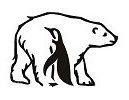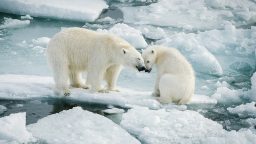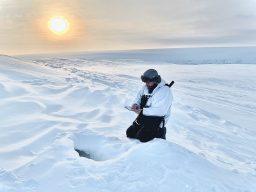
Russian scientists were the first in the world to evaluate the parameters of the population health of a rare species of birds – the white gull, the results of the work done especially for the Day of Birds, which is celebrated on April 1, were shared by employees of the Arctic and Antarctic Research Institute.
The white gull (Pagophila eburnea) is a rare and small species of seabirds listed in the Red Books throughout its range. It is endemic to the Arctic and on average the northernmost of all birds. Its breeding area is located in high latitudes — from the Canadian Arctic Archipelago, Eastern Greenland, Svalbard to the islands of the Kara Sea and the Northern Land. Most of the range of the species correlates with the Arctic zone of Russia in the region of the Kara and Barents Seas.
Climate change, the associated reduction of sea ice, especially pronounced in the last 30 years, environmental pollution and rapid industrial development of the shelf are the main threats to the populations of the white gull. In Russia in the 2000s, the number of these birds was considered relatively stable, but now, due to the ongoing rapid warming of the Arctic, the Russian population of the white gull has also begun to decline.
Scientists of the Arctic and Antarctic Research Institute conducted monitoring and comprehensive studies of the Russian white gull population (its abundance, fertility, food supply, health status) during the field seasons of 2020 and 2022. Stationary work was carried out on the island of Vize in the north of the Kara Sea. A platform was laid here for the study of the white gull and other seabirds.
Currently, research is being conducted using the most modern technologies. So, scientists track the movements of birds using GPS trackers. We have already managed to collect unique data on the so-called forage dispersals of birds. It turned out that in search of prey in the arctic waters, gulls can move several tens of kilometers away from their colony.
According to experts from the Arctic and Antarctic Research Institute, ice conditions for nesting white gulls in 2022 were much better than in 2020. Last season, on the island of Wiese, some pairs of seagulls laid three eggs. This also indicates good feeding conditions. However, the breeding of offspring was not calm.
— Last season, the beginning of the nesting of white gulls on the island of Wiese was quite successful. There were a lot of birds in the colonies, there were two or three eggs in the clutches, which is a very good indicator for white gulls. But then trouble came: first, a bear came to the colony, ravaging more than half of the nests. Noticeable damage to the offspring was caused by loose dogs.
Also, many chicks died as a result of internecine strife — with too dense nesting in the anthropogenic landscape, the aggression of the gulls greatly increased, which led to a significant death of the chicks. Nevertheless, by the end of August, the first white gulls with black markings on the wings and tail appeared in the air — young birds rose to the wing, — said Maria Gavrilo, a leading researcher at the Arctic Shelf laboratory of the Arctic and Antarctic Research Institute.
For comparison, in 2020, in the very core of the area in the Kara Sea, at the same time, completely unsuccessful nesting was noted for the first time in four largest colonies of the white gull. Not a single chick has hatched all season! According to scientists, the reason was the shortage of forage resources at the beginning of the breeding season, which arose due to the unavailability of suitable food production sites. In general, in six colonies under observation for the last 15 years, the total number of gulls in the 2020 season has become minimal.
The analysis of the chicks’ nutrition revealed the limitations of their diet. Most of the food was made up of small young northern fish — saiki (Boreogadus saida). Moreover, the gulls could only extract them if there was ice in the sea around the colony. Such conditions were observed only in 2022. In 2020, after opening the solder and clearing the water area around the island of ice, all the gulls abandoned their nests and left the colony. At the same time, the moevki nesting in the neighborhood successfully bred offspring in both seasons, since they were able to extract saika both among the ice and in open water.
Studies have yielded other, no less interesting results.
— For the first time in world scientific practice, we analyzed blood samples and anomalies in the cell nucleus of the erythrocytes of white gulls. The data obtained showed that females of this species experience a much greater stress load than males. We still have to figure out what this is connected with,” Maria Gavrilo noted.
Now scientists continue the desk processing of the collected samples and information. This study will significantly supplement the knowledge about the biology of the white gull and will allow us to develop a program of measures to preserve the population of a rare species.
AANI
More amazing facts about the Arctic can be read here.


